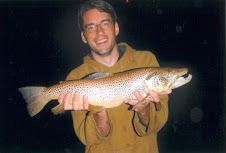
Bobbers have been used by fisherman since, well, probably since the inception of the modern idea of fishing. Whether it is an in-depth top secret bobber rig for steelhead, or a simple worm and weight under a bobber for panfish, bobbers (or indicators, for those who shudder when they hear the term "bobber") are used across the entire spectrum of fishing. Pictured above is just a small sample of the floats, bobbers, or indicators one can buy on the market. Some are definitely better than others. In Michigan, fishing with a bobber has become the go to method in fishing for steelhead. In the past 15 years, the trend has gone from almost 100 percent "chuck & duck," fishermen to a majority of bobber fisherman that one will see during the fall, winter, and spring runs. Now, I will be the first to admit that not all the water on our rivers here can be fully covered by either method, but bobber fishing can greatly outshine the chuck & duck method at certain times. Bobber fishing allows the flies to float over structure that chuck & duck would get snagged up on. In addition to this indicator fishing can be very productive for trout on our rivers during the summer months. I can't tell you how many times, as a kid fishing the Au Sable, that well known guides would pass by me, see an indicator on the leader of my rod, and go "hmm... I never thought of that." Indicator fishing produced some really nice daytime trout for me, even as conventional wisdom led others to believe that 18 plus inch trout were strictly nocturnal.
As I stated earlier, some bobbers are better than others, and none of them can cover all the types of flyfishing one would encounter here in Michigan. For example, during the fall and early winter, I pretty much exclusively use thill ice n fly bobbers, which are in the picture to the left.

I love the way these bobbers float upright when paired with the correct amount of weight under them. In the dead of winter, I will use this bobber, but I usually elect to go with Drennan or Blackbird floats (pictured below). These plastic floats have incredible soft strike detection, and during the winter this is key because at this time steelhead with "mouth" and eject a fly very quickly. In the spring, I move to a bobber that has taken our sport by storm in the last 2 years. The Thingamabobber, while it has a long name, is an unbelievably low key bobber. During the spring run, when the fish are on gravel, a fisherman needs a bobber that won't spook the fish when overhead. This bobber is made of colored (or white) clear plastic that does not cast a shadow on the river bottom. Finally, during the summer months, I use either a small thill ice n fly bobber or a foam indicator (pictured above) for trout, because in general less weight is needed to get down for trout.

To summarize, the key to finding a good bobber, float, or indicator is to find one that you are comfortable with. Even though the most important element to a bobber is the way it floats, look at other components as well including adjustability and visibilty. Bobber fishing has really opened up a lot of formerly "unfishable" spots for me, and I am certain it will for you as well.



No comments:
Post a Comment